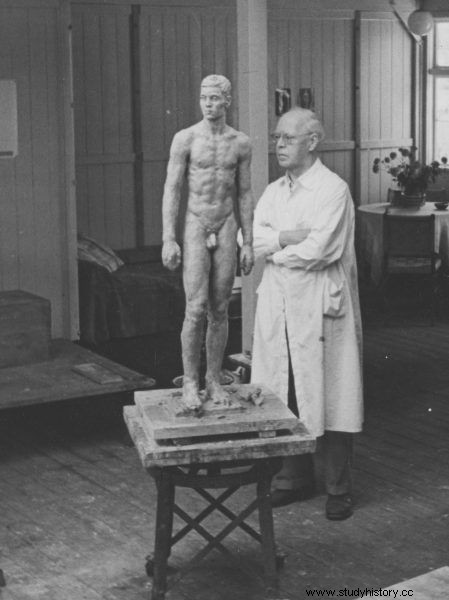“A man may also be subject to sexual abuse. It may happen that a woman will commit lewd acts against a man, which for this purpose she will make into a state of defenselessness or unconsciousness, warned in 1925 a Vilnius law professor. How many such cases have there been? How were the perpetrators punished?
Pre-war Polish jurists loved to dress up in the feathers of progressives. They used every opportunity to draw attention to the reformist spirit of the Penal Code, finally introduced in 1932, after many years of discussions and heated disputes. Most of the time, they patted their backs in recognition of completely phantom achievements. Once, however, their efforts in fact turned out to be progressive.
They provided at least theoretical protection to victims who had been completely unnoticed until now. And whose suffering was of no importance to the judgments.
Female rape under the law
"The old codes essentially defended only women against violations of their sexual freedom by men" - explained Paweł Horoszowski in 1937 in the pages of Handheld Encyclopedia of Criminal Law . This glaring gap was first noticed by the Vilnius law professor, Stefan Glaser.

Statue of a young man, late 19th century.
“A man may also be subject to sexual abuse (…). It may happen that a woman commits lewd acts against a man, and for this purpose she makes him vulnerable or unconscious. Here, the passive behavior of a man is enough, ”he explained in a paper published in 1925 and addressed to the authors of the new regulations. His remarks apparently influenced the members of the codification commission, because in 1932 a supposedly minor but fateful change was introduced. Any gender designation has been dropped.
"Both the perpetrator and the victim of all crimes provided for in the chapter on prostitution can be both a man and a woman," wrote Horoszowski. He referred not only to the content of the code, but also to the actual state of affairs.
"Women's inclination towards male youth is definitely universal"
Teachers, tutors, servants ... The Warsaw lawyer was sincerely afraid of the promiscuous attraction of all female employees coming into contact with young people, especially boys. And he was convinced of their complete impunity. "These women, occupied constantly around minors, can easily cover sexual harassment under any alleged pretense (...), especially since in these cases there is usually no normal sexual intercourse" - he explained.

The darkest sides of pre-war Poland. The book is now on sale at empik.com.
Similar objections to all sorts of babysitters were expressed three decades earlier by the Krakow sexologist Stanisław Kurkiewicz. It is worth approaching his controversial, and often even crazy, findings with a healthy distance. This time, however, Kurkiewicz wrote about a phenomenon that affected him personally. And that's at an age when he simply couldn't counteract it.
“The inclination of women towards male youth and children is definitely universal. It gives rise to various abuses, usually criminal and harmful to a male person ”- he explained on the pages of of the Detailed Distinguishing of Sexual Activities. He even coined the term "boyhood". This criminal act was to manifest itself in a "wagging" performed on deceived boys. According to Kurkiewicz, some servants or governesses also went so far as to "sex with a boy".
The doctor himself recalled that at the age of five he fell victim to the "maid Kasia", who took to his genitals without consent. At the age of eight, he was taken to bed by the "15-year-old nurse Zosia". She forced him to have sex several times. So an activity that at such a young age he didn't even have the right to understand.

Bathroom interior in a bathing car. Photograph of the Illustrated Daily Kuryer
"They calm children by stroking their sexes"
Kurkiewicz was convinced that every woman, without exception, had a tendency to molest children of the opposite sex. He exaggerated the scale of the phenomenon based on his own traumatic experiences. But he was by no means lying. There is an abundance of accounts of similar deeds in the literature of this era.
A successful specialist in the field of impotence, Stanisław Higier, cited the example of an Orthodox Jew who could not have a normal relationship with his wife. The doctor pointed out that the man, as a child, was under the care of a servant who was several years older than her, who played with his sexual organs. The authors of brochures addressed to parents and educators also warned against nannies who soothe children by “stroking and tickling the sex or the faecal hole”.
The problem was finally signaled by sexology textbooks. A mention of "nymphomaniacs" who "force young boys to have sexual intercourse and often infect them with syphilis" can be found, for example, in the pages of Rational Sexual Life from 1936.

The darkest nooks and crannies of human nature in Kamil Janicki's book “The Age of Silence. Pre-war Poland, which we are ashamed to talk about. ” Buy with a discount on empik.com.
1 woman in 200 men?
If something was missing it was hard evidence. In Germany, for every 200 men convicted of "prostitution with minors", there was one woman. No similar statistics were kept in Poland. We know that rape of men did happen, for example, from sexological studies.
The already mentioned Stanisław Higier described the case of his patient who "was literally seduced by his current sexual partner". Today that sentence sounds innocent enough. Before the war, however, "seduce" meant nothing less than rape.
It is much more difficult to find similar examples in official documentation. In the police or prosecutor's files only single acts of "boyhood" can be indicated. Even rarer were cases on the Vistula, confirmed by judicial authorities, where a woman led a man to intercourse by force or threat. So female rapes. There could have been several such cases throughout the interwar years. However, the Central Statistical Office recorded only ... one.

The artist at the sculpture depicting a male nude. Photograph from the beginning of the 1940s.
Only case on file
In 1924, an unspecified adult woman was accused of violating the rape clause. The trial took place in Warsaw. The defendant was punished twice before, though not necessarily for sexual offenses. The detainee was still tried according to the old Russian code, remembering the times of the partitions. In its light, only a woman could be raped. However, the sex restriction did not apply to offenses against minors, so it had to be an act committed against a boy under the age of 14.
It is impossible to say what touched the court the most:the age of the victim, recidivism or perhaps the nature of the offense. In any event, the sanction turned out to be extremely severe by the standards of the Warsaw Court of Appeal. The woman was sentenced to one to two years in prison (more precise data are not available). It was therefore more restrictive than 62% of all rape convictions during this period. The woman was also deprived of her civil rights.
The rapist's personalities remain a mystery. As was the number of cases that did not go to the police and that nobody spoke about. Because rape of men turned out to be a phenomenon as shameful and burdened with a social taboo as the sexual exploitation of women.
